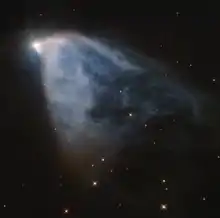| Reflection nebula | |
|---|---|
| Variable Nebula | |
 | |
| Observation data: J2000.0 epoch | |
| Right ascension | 6h 39m 10s[1] |
| Declination | +8° 45′[1] |
| Distance | 2,500 ly |
| Apparent magnitude (V) | 9.0 |
| Apparent dimensions (V) | 2′ |
| Constellation | Monoceros |
| Designations | Hubble's Variable Nebula,[1] Caldwell 46 |
NGC 2261 (also known as Hubble's Variable Nebula or Caldwell 46) is a variable nebula located in the constellation Monoceros. The nebula is illuminated by the star R Monocerotis (R Mon), which is not directly visible itself.
Observing history
The first recorded observation of the nebula was by William Herschel on 26 December 1783, being described as considerably bright and 'fan-shaped'.[2] It had long been designated as H IV 2, after being the second entry of Herschel's class 4 category for nebulae and star clusters, in his catalogues of nebulae.[3]
NGC 2261 was imaged as Palomar Observatory's Hale Telescope's first light by Edwin Hubble on January 26, 1949,[4] some 20 years after the Palomar Observatory project began in 1928. Hubble had studied the nebula previously at Yerkes and Mt. Wilson.[4] Hale had taken photographic plates with a 24-inch (60.96 cm) reflecting telescope in 1916.[5] Also, plates were taken using the same telescope in 1908 by FC Jordan, allowing Hale to use of a blink comparator to study any changes in the nebula.[5]
NGC 2261 was imaged by the Hubble Space Telescope, and an image of the nebula was released in 1999.[6]
A timelapse of NGC 2261 was taken over a period of 6 months by over 20 amateur astronomers at the Big Amateur Telescope from October 2021 – April 2022. In August 2022, the project was resumed as NGC 2261 came out from behind the Sun.[7]

Descriptions
The star R Monocerotis has lit up a nearby cloud of gas and dust, but the shape and brightness slowly changes visibly even in small telescopes over weeks and months, and the nebula looks like a small comet.[8]
One explanation proposed for the variability is that dense clouds of dust near R Mon periodically block the illumination from the star.[9] This casts a temporary shadow on the nearby clouds.[10]
See also
References
- 1 2 3 "NGC 2261". SIMBAD. Centre de données astronomiques de Strasbourg. Retrieved 2007-04-11.
- ↑ Herschel, William (1786). "Catalogue of One Thousand New Nebulae and Clusters of Stars. By William Herschel, LL.D. F. R. S." Philosophical Transactions of the Royal Society of London. 76: 457–499. ISSN 0261-0523. JSTOR 106639.
- ↑ Duncan, John C. (1956). "Lampland's Study of Hubble's Variable Nebula, NGC 2261". Publications of the Astronomical Society of the Pacific. 68 (405): 517–519. doi:10.1086/126989. ISSN 0004-6280. JSTOR 40676213. S2CID 119513655.
- 1 2 "Citizen Science". 26 January 2009.
- 1 2 Hubble, E. P. (1916). "The variable nebula NGC 2261". Astrophysical Journal. 44: 190. Bibcode:1916ApJ....44..190H. doi:10.1086/142284.
- ↑ "Hubble's variable nebula (NGC 2261)". www.spacetelescope.org. Retrieved 2018-07-25.
- ↑ "Hubble's variable nebula Project". bigamateurtelescope.com. Retrieved 2022-12-24.
- ↑ "Hubble's Variable Nebula, NGC 2261". Planetary Science Institute. 2010-10-15. Retrieved 2018-07-25.
- ↑ Arny, T. T.; Bechis, K. P. (1978). "A model for the cometary nebula NGC 2261". The Astrophysical Journal. 226: 455. Bibcode:1978ApJ...226..455A. doi:10.1086/156627.
- ↑ "NGC 2261: Hubble's Variable Nebula | Science Mission Directorate". science.nasa.gov. Archived from the original on 2020-08-05. Retrieved 2018-07-25.
External links
- European Homepage for the HST – Hubble photos and information on NGC 2261
- wikispaces.com Archived 2013-02-09 at archive.today – Images by amateur astronomers
- Astrobiscuit: Seeing The Speed Of Light fun and educational video about variable nebula and the amateur community observing them
- NASA Astronomy Picture of the Day: NGC 2261: Hubble s Variable Nebula (November 8, 2017)
- NGC 2261 on WikiSky: DSS2, SDSS, GALEX, IRAS, Hydrogen α, X-Ray, Astrophoto, Sky Map, Articles and images